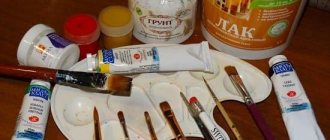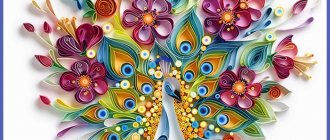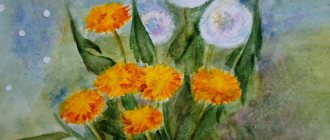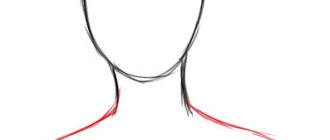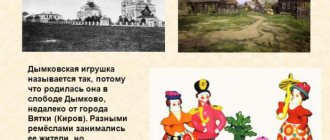Summary of a drawing lesson in the senior group.
Author: Valentina Ivanovna Usova, teacher, MBDOU combined type kindergarten N27 “Golden Key”, Bugulma, Republic of Tatarstan. Goal: to introduce children to the art of pottery (ceramics)
- Teach children to paint a jug using familiar elements characteristic of ceramic painting: stripes, wavy lines, dots, curls, flowers;
- Strengthen drawing techniques by applying the entire bristle of the brush to the paper, drawing lines from left to right, and the ability to draw with the tip of the brush.
Develop aesthetic perception.
To cultivate respect for the work of folk craftsmen and admiration for their creativity.
Vocabulary work. ceramics, potter.
Materials and equipment: sample, ready-made template drawings of jugs (silhouettes), paints, brushes, water, napkins.
Preliminary work: conversations, looking at paintings about ceramics, teacher’s story.
Progress of the lesson:
Educator. Guys, guests came to our lesson today. They want to see how we do things. First, let's remember and name the rules of behavior. And we will conduct a lesson in painting with paints. And what we will draw, you have to guess for yourself. Listen here. This product is made of clay. It is placed on the table when guests are invited to the house. Usually mineral water or juice is poured into it. What do you think this could be? Yes, guys, this is a jug. (A jug is brought in) And we will talk about dishes, or rather about pottery, which the master potter made from clay, and then dried in the oven and applied a beautiful pattern. This pottery art is called ceramics. (Repeat). Tell me, please, who is this potter? (Yes, this is the one who makes dishes from clay) What is ceramics? So today in class we will make a pattern on the silhouette of a jug. (Sample is entered)
Look at the pattern I drew on the jug. What elements does it consist of? And where are they located? (Children's answers)
Now let's remember the techniques for drawing wide stripes and wavy lines. How should you draw flower petals? (Children's answers) Yes, they need to be painted by applying the entire bristle of the brush to the paper and turning the brush in a circle. Who wants to show how this should be done? (Go to the board) Okay, guys. Now tell me how to use paints correctly? (Children’s answers) But before we get to work, let’s do some physical education.
Now we will draw, It will be difficult not to get tired, We will rest a little. Let's start drawing now.
Now sit down comfortably and let's get started. Where do we start working? Where should we draw stripes and wavy lines? (Children’s answers) (During independent work, I keep all the children in sight, monitor their posture, and advise those who have difficulty to turn to other children for help) Summary of the lesson. (I display several children’s works on the board) Guys, I think these works turned out to be very successful. Why do you think? How are they different from other jobs? What's special about them? (Children's answers) Did you like these works? (I’m displaying the rest of the work. Children’s answers) Today in class you all tried very hard and that’s why all the jugs turned out beautiful and neat. Well done boys!
On the topic: methodological developments, presentations and notes
Summary of a lesson on decorative drawing in the senior group “Gorodets painting”.
I conducted this lesson in the senior group, it helped the children become better acquainted with the elements of Khokhloma painting.
Continue to introduce children to folk art using the example of Zhostovo masters.
Decorative drawing based on the fairy tale “Ryaba Hen (based on Dymkovo painting)” Purpose: To consolidate children’s knowledge about Dymkovo painting, developing the ability to create patterns on their own.
Summary of a lesson on decorative drawing in the senior group.
Educational objectives: - to arouse in children the desire to paint dishes based on Khokhloma painting. - based on knowledge about Khokhloma craft, to consolidate the ability to create an independent composition.
Summary of a lesson on decorative drawing in the preparatory group “Painting a board based on Gorodets painting.”
Source
Master class on drawing for children 5-7 years old “Gzhel” step by step with photos
Master class on drawing for children 5-7 years old “GZHEL” with a felt-tip pen step by step with photos
Sredina Olga Stanislavovna, teacher, head of the art studio of the MDOU TsRR d.s. No. 1 “Bear Cub”, Yuryuzan, Chelyabinsk Region Purpose: Creation of educational works Materials: White A3 paper, felt-tip pens, wax crayon, brushes, water. Goals: Getting to know the blue Gzhel Objectives: Learning how to draw Gzhel patterns Fostering patriotism Developing curiosity, fantasy and imagination Preliminary work: 1 - Getting to know Gzhel (presentation, story about the fishery) 2 - Viewing the presentation Birds:
Landscapes: Blue Gzhel looks great in any materials. This is embroidery on fabric, felt boots, ribbon embroidery, wood painting, applique, stained glass, tiles, quilling. Variations on a Gzhel theme: Literary supplement: Poems about Gzhel
A simple pattern of paint shades, White clay, porcelain - attributes of a fairy tale!
It was like a child’s hand on pieces of clay, painting blue pictures in three strokes. The round sides of the cups were painted into rings, into petals and clouds - tiles for the stove, blue lace, cobalt frost, as if a blizzard had laid out curlicues of lines. I made blue figures for the game, for the children's amusement, hares and whistles. Hidden in the lightness of the stroke is the secret of the miracle of clay. An ancient craft has lived in Rus' for centuries. Generations of masters of white and blue Gzhel - Sorcerers of two colors, our Botticelli! Svetlana Ledkova
From time immemorial to the present day, Through the efforts of skilled craftsmen, Russia decorates the miracle of Gzhel with a blue pattern in white dresses.
The spring morning of Wonderful Gzhel will be decorated with delicate bouquets, And as if a light breeze will blow on us in the hot summer. Sometimes in autumn, in the bright colors of Nature’s sweet creation, Gzhel comes to us like a snowy fairy tale, Winter, anticipating its approach. Well, in the cold, blizzard winter, the fireplace will warm us with fire, in which the hot flame is friends with the blue-blue pattern. Practical work: Gzhel is a Russian folk craft producing ceramics and a type of Russian folk painting. Let's get acquainted with the elements of Gzhel painting. This is a mesh, a droplet, a stroke with a shadow, various borders. We draw them with a brush, and then take felt-tip pens in our hands.
1 – jug
We trace the outline of the jug through carbon paper (for the older group). Pupils of the preparatory group trace the cardboard blank independently.
We finish drawing the demarcation lines. Separate the spout, lid, bottom and handle from the body.
We decorate the bottom and lid with a “mesh” pattern. Draw patterns on the handle and nose
We begin to draw the body of the bird. We draw the head, crest, beak, paws. Add two ovals. These are future wings. Draw a tail.
We strengthen the tail with additional feathers. We decorate the wings with a mesh pattern.
At the ends of the wings we draw feathers. Continuing the crest, draw a decorative flower above the bird. Children's work: (preparatory group) Some jugs depict not a bird, but a fish. Drawing a fairytale fish is even easier than drawing a bird. 2 – cheese board
Birds are a little easier to draw on a cheese board. Their wings are folded. The main decoration is a large tail. The hole on which the plaque hangs becomes the center of a fairy-tale flower. Children decorate the edges of the cheese board in their own way, using familiar elements of painting. We shade the background with wax crayons. Draw easily, hold the crayons flat. Children's works: (senior group) 3- Gzhel landscape
To achieve the effect of a brush stroke, we will apply a partial blur of the image. The felt-tip pen will “flow” slightly, but a clear edge will remain.
Drawing the mansion Drawing the main rectangle. Then we add an extension to it. We build on the acute-angled and obtuse-angled roofs of the tower. We decorate the roofs, draw a balustrade, and depict logs with horizontal stripes.
We place a small hut on a hillock. Draw a roof with a pipe. Adding clouds, trees and bushes
Blur the drawing.
Children's work: (preparatory group) 4 - Easter egg Pupils of the middle groups drew a church on an Easter egg with felt-tip pens and blurred the drawing themselves. You can also do it with wax crayons. In this case, the drawing will be more accurate. On the reverse side of the sheet you can depict flowers or a Gzhel bird.
We recommend watching:
Painting a tray with a Zhostovo pattern. Master class with step-by-step photos Unconventional technique of painting with gouache using tree leaves for children from 5 years old step by step Master class on drawing for children 5-6 years old. Animals of hot countries Master class on drawing for children 5-7 years old on the topic: Spring step by step with photos
Similar articles:
Painting of Gzhel plates. Master Class
